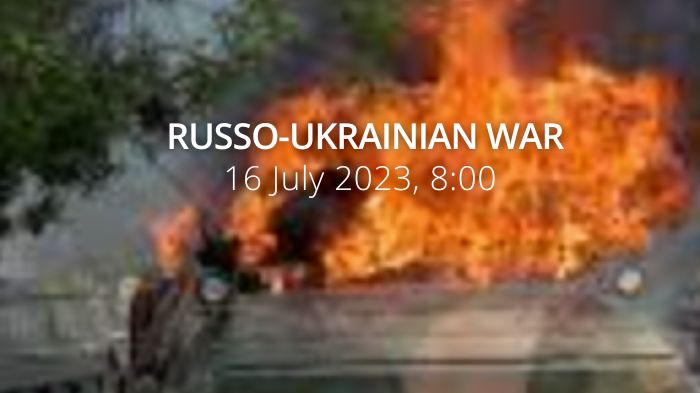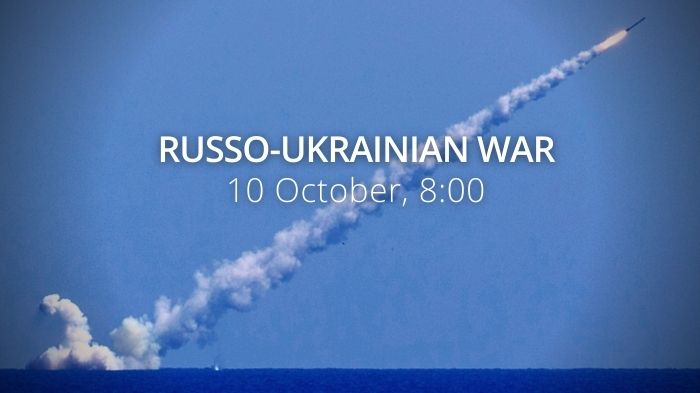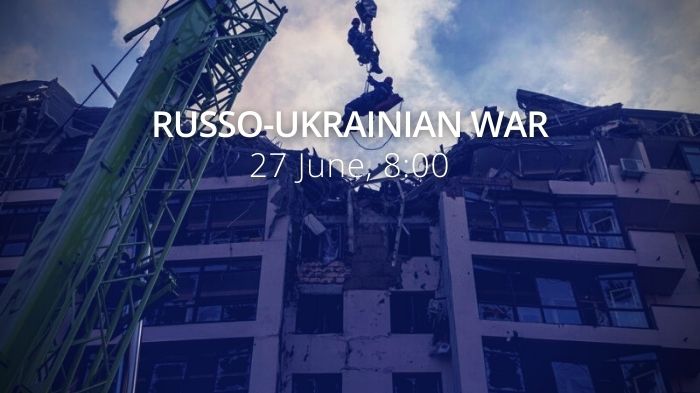Russian army continued offensive operations northwest and east of Sloviansk and try to advance toward Siversk. The Ukrainian army conducted a limited counterattack southwest of Donetsk. Residents of Russian-occupied Mariupol are dying from a lack of medicines. Ukraine to receive self-propelled artillery systems, and loitering munitions from Britain. War will end when Ukraine reaches its 1991 borders, as per the Head of Ukrainian Intelligence.
Daily overview — Summary report, July 6
Key points of military expert Stanislav Haider’s assessment of the July 6 morning:
A map of the approximate situation on the ground in Ukraine as of 00:00 UTC 05/07/22. pic.twitter.com/Cg5RdVg18W
— War Mapper (@War_Mapper) July 5, 2022
Donetsk oblast. Ukraine-controlled Bohorodychne and Krasnopillia are holding on. Apart from Mazanivka, Russians didn't achieve any other successes in the Sloviansk direction. The battles for Bilohorivka (the one near the Siverskyi Donets river) are still going on.
The Russian offensive on Sloviansk: a massive attack with a tank breakthrough under the artillery cover should have started 7-10 days ago. But as the Ukrainian Armed Forces destroyed key warehouses all across Russia's entire rear, it caused a shortage of shells forcing the Russian troops to slow down. The Ukrainian military came close to Izium west of the city, which began to threaten this key Russian hub of communications and control for the scheduled offensive on Sloviansk. The Ukrainian actions at the Pechenihy reservoir also jeopardized reliable and safe Russian logistics to Izium. Intense battles imposed on the Russians in the remained parts of Luhansk Oblast resulted in huge Russian losses crippling the ability of their troops to carry out an operation on such a large scale as an offensive on Sloviansk. It is unknown now when the Russians will be able to launch a massive attack on Sloviansk and how it will end.
South of Donetsk Oblast. Ukraine might have had some success in the Vuhledar area, which hasn't been officially confirmed yet. Also, in the area of Ukraine-held Donetsk suburb of Mariinka, the Ukrainian military carries out irregular counterattacks in small groups, improving its tactical position. Russians are trying to reinforce Volnovakha and Dokuchaivsk with troops forcibly mobilized from ORDLO - parts of Donetsk and Luhansk oblasts occupied by Russia since 2014.
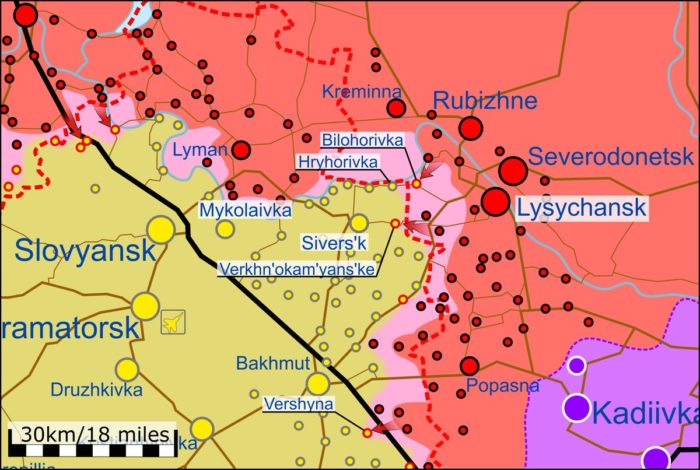
Kharkiv Oblast. The was no change near the state border. Threatened that at some point the Ukrainian army will reach the city of Izium, the Russian forces moved one battalion-tactical group to the city group from Sievierodonetsk hoping to push back the Ukrainian troops further to the west from Izium.
Zaporizhzhia oblast. Artillery duels continue in the direction of Polohy. In the direction of Vasylivka, Ukraine managed to slightly improve its tactical situation. The direction of Huliaypole didn't see much change as the Russian troops have been reinforcing that area yet their reinforcements came from Luhansk Oblast, badly beaten, so those aren't likely to affect the operational situation.
Kherson Oblast. To the west of Kherson, the Armed Forces of Ukraine knocked out the Russian forces from certain positions and settlements, regaining control over some positions on the left bank of the Inhulets river. Now the Russians are trying to retake their lost positions but without success.
Over the past day, the Ukrainian artillery hit Russian warehouses in occupied Donetsk and Horlivka.
The General Staff’s operational update regarding the Russian invasion as of 06.00 am, July 6, 2022 is in the dropdown menu below.
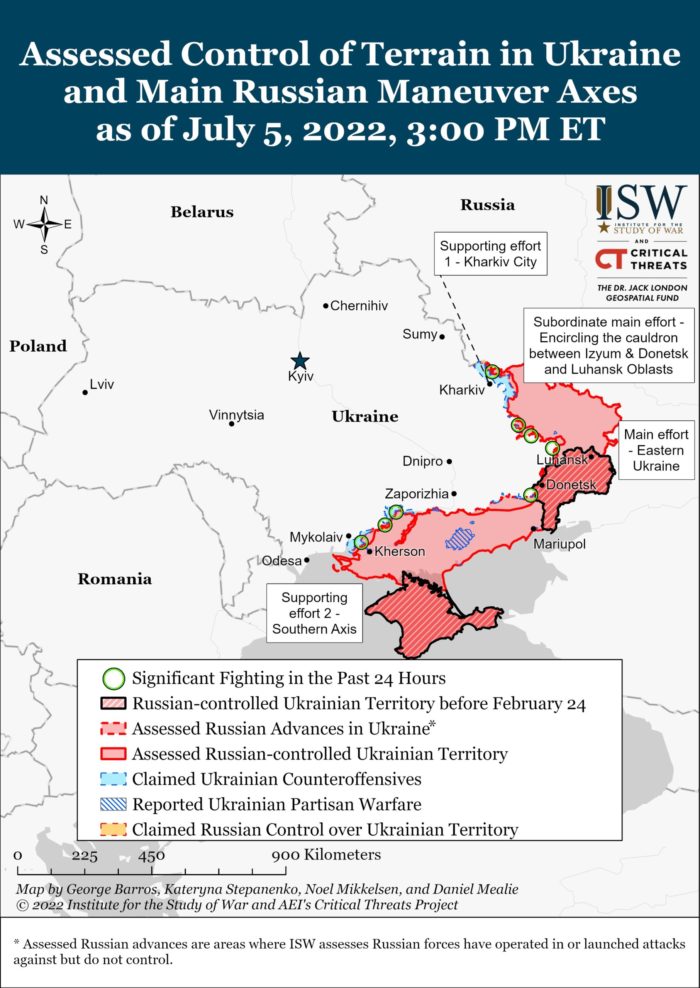
According to information from the General Staff as of 06.00 06.07.2022, supplemented by its [18:00 assessment].
“[Russia continues to launch missile attacks on military and civilian objects on the territory of Ukraine.]
On 5 July at 4 am, Russia launched 7 missiles towards Dnipropetrovsk Oblast. 6 of them were downed by Ukraine's air defense which is the most efficient result so far.
Ukraine's Air Force shared the video of the interception. https://t.co/spo4PoclNs pic.twitter.com/Z3Qjcpxd3i
— Euromaidan Press (@EuromaidanPress) July 5, 2022
On the Volyn and Polissya directions, the situation has not changed significantly. No signs of the formation of enemy offensive groups on the territory of the Republic of Belarus were detected. [The threat of missiles and airstrikes from the territory of the Republic of Belarus continues. According to the available information, the control and alert system is being checked in the Armed Forces of the Republic of Belarus.]
In the Siversky direction, the aggressor fired at the positions of our troops in the areas of Zalizniy Mist, Shalyhine and Esman settlements. Improves engineering equipment of advanced positions in border areas. [Yesterday, Russian forces fired at our positions near the settlement of Mkhy and carried out an airstrike near Esmani.]
[In the Slobozhansky direction:]
- Russian forces are conducting defensive operations in the Kharkiv direction. Shelling from helicopters, tanks, mortars, artillery and MLRSwas recorded in the areas of Sosnivka, Slatyne, Mala Danylivka, Cherkasky Tyshky, Vesele, Kutuzivka, Mospanove, Husarivka, Chepil and Nova Mykolaivka. [Yesterday, Russian forces used tanks, mortars, artillery and MLRS for shelling the areas of the settlements of Udy, Dementiyivka, Nove, Ruski Tyshky, Tsyrkuny, Kutuzivka, Bazalivka, Pryshyb, Shevelivka, and Protopopivka. He conducted an assault near Sosnivka, had no success, and withdrew. Conducted an airstrike in the Kharkiv area.]
- Russian occupiers remotely mined the area near Shestakovo and Peremoha.
- In the Sloviansk direction, Russian forces are trying to improve the tactical position of their units. Fired from mortars, artillery and MLRS near Krasnopilla and Bohorodychne. Our defenders repelled Russian forces assault and pushed the invaders back to the Dolyna settlement area. Russian forces are conducting assault operations near Mazanivka, and the fighting continues. [Yesterday, artillery shelling was recorded near Dibrovny, Dolynaya and Adamivka. Our soldiers successfully repelled enemy assaults in the Krasnopil region.]
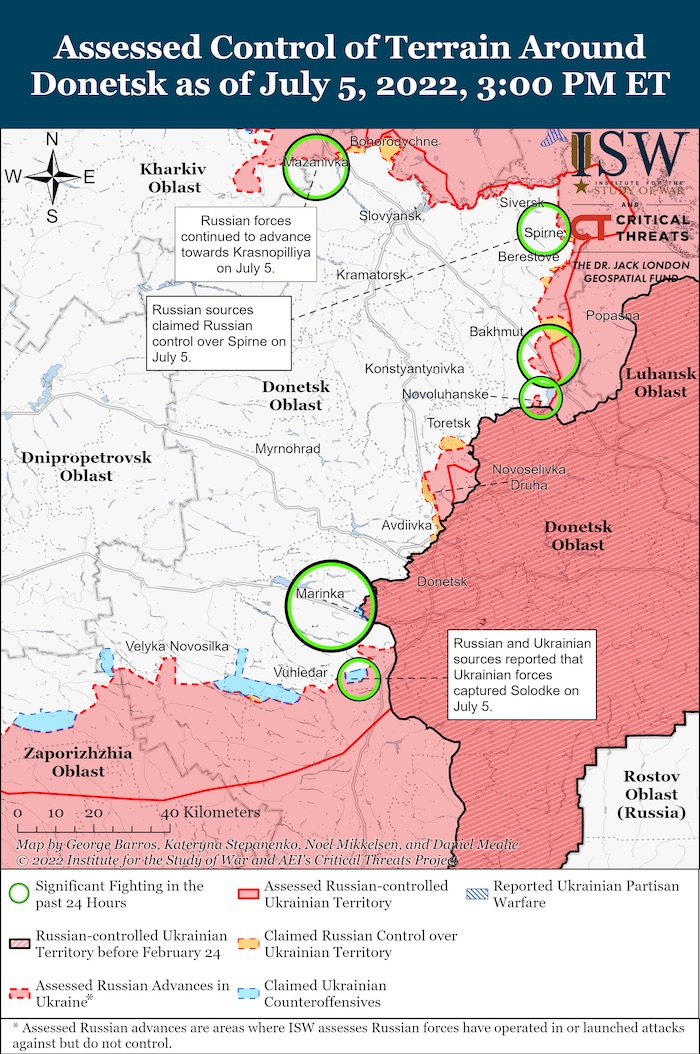
[In the Donetsk region, the main efforts of Russian forces are concentrated on taking control of the Bakhmut - Lysychansk road and attempts to seize the settlement of Bilohorivka.]
- The invaders are advancing in the Luhansk region, and hostilities continue.
- In the Kramatorsk direction, Russian forces shelled civilian infrastructure in the districts of Siversk and Hryhorivka. Ukrainian soldiers inflicted significant losses on Russian forces during his attempted offensive in the areas of Verkhnokamianske, Bilohorivka and Hryhorivka settlements. The occupiers retreated. [Yesterday, Russian forces fired at civilian infrastructure in the Kryvya Luka and Serebryanka districts. Launched a missile and air strike near Siversk. Fighting continues in the Bilohorivka area.]
- In the Bakhmut direction, Russian forces shelled our positions with artillery of various calibres near Berestove, Bilohorivka, Travneve, Shumy, and New York. It carried out an airstrike in the area of the Vuhlehirska TPP. With the support of artillery, it conducted assault operations in the area of the settlement of Novoluhanske, it was unsuccessful, and it withdrew. Our soldiers stopped a Russian offensive in the area of Spirne and repelled the attack near Vershyna. They inflicted losses on the occupiers and pushed them back. Russian forces are trying to regroup. [Yesterday, Russian forces shelled our troops with mortars, artillery and MLRS in the areas of Kodema, Pokrovske, Zaytseve, Zalizne and Novoselivka settlements.]
- [With the support of artillery and operational-tactical aviation, the occupiers carried out assaults in the areas of Spirne and Vershina settlements, and the fighting continues.]
- In the Avdiivka, Kurakhivka, Novopavlivka, and Zaporizhzhia directions along the contact line, shelling from mortars, artillery and MLRS continues. Russian forces carried out airstrikes near Avdiivka.
In the Pivdenny Buh directions, enemy artillery shelled the areas of Trudolyubivka, Knyazivka, Mykolaivka, Topolyne, Kobzartsi, Blahodatne, Shevchenkove, and Lupareve settlements. Russian occupiers continue to launch rocket attacks on objects in the Mykolaiv region. Further threat of such actions remains. In readiness for the mission of missile strikes on objects on the territory of Ukraine, it keeps four carriers of high-precision weapons in the sea.
- Ukrainian soldiers harshly repressed the invaders' attempt to advance in the direction of Lozove. Russian forces continue measures to replenish losses.
Ukrainian strike aviation continues to attack Russian forces in several strategic directions. So, last day, bombers and attack aircraft of the Air Force of the Armed Forces of Ukraine destroyed two field ammunition depots, two platoon strongholds of the Russian occupiers and more than 10 units of enemy equipment. Losses in manpower are being clarified.
[Our units continue to successfully carry out missile and artillery fire missions in the designated directions. It is becoming more and more difficult for Russian forces to replenish units suffering losses as a result of waging war on the territory of Ukraine.]”
Military Updates
Russians moving into Ukraine's Donetsk, Reuters reports. “Russian troops are engaged in heavy fighting and making their way into Ukraine's Donetsk region after taking control of the last two towns in neighbouring Luhansk, the regional governor of Luhansk said on Tuesday. Serhiy Gaidai said the Russian troops had sustained heavy losses in the long process of capturing the twin towns of Sievierodonetsk and Lysychansk, but were channelling their efforts into moving southward.”
Ukraine forces down nine Russian missiles, two ammo depots, and invaders' strongholds, Ukrinform reports. “On July 5, the air defence units of the Ukrainian Air Force destroyed nine Russian cruise missiles, while the strike aircraft destroyed two ammunition depots, two platoon strongholds, and more military equipment, [the Air Force claimed].”
No need for forced mobilisation of women at the moment - Ministry of Defence of Ukraine, Ukrainska Pravda reports, citing Hanna Maliar, Deputy Minister of Defence of Ukraine. “There is currently no need for forced mobilisation of women into the Armed Forces of Ukraine, and there are no plans to restrict women's travel abroad.
Russians have strengthened the security of the Crimean Bridge, Ukrainska Pravda reports, citing RIA News Crimea. “The Russian occupiers have strengthened their missile and air defences and the security of the Crimean Bridge to repel a possible attack by the Armed Forces of Ukraine.”
According to British Defence Intelligence, (last 48 hours):
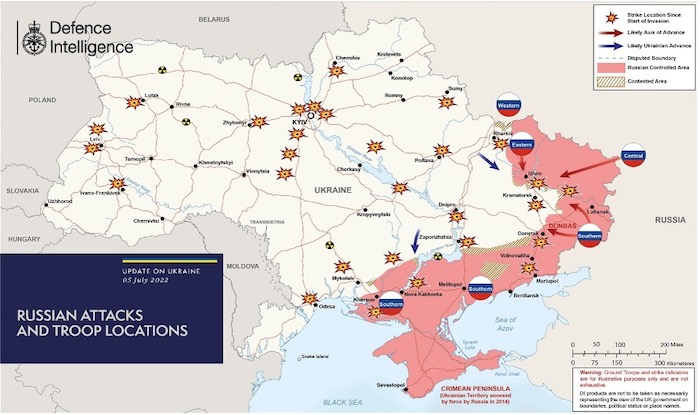
- Russia likely continues to consolidate its control over Lysychansk and Luhansk Oblast. To the north, it has committed most of the remaining available units from the Eastern and Western Groups of Forces to the Izium axis.
- Over the last week, Russian forces have likely advanced up to another 5 km down the E40 main road from Izium, in the face of extremely determined Ukrainian resistance.
#OTD 5 July, 2014-liberation of Sloviansk, Donetsk Obl.
Rebuilding & renovation began slowly; Sloviansk was once again part of free Ukraine.Today, after razing Lysychansk & Sievierodonetsk in Luhansk Obl, Russian forces are again shelling Sloviansk & Bakhmut.
#ArmUkraineNow pic.twitter.com/x7kZQxODxO— Euromaidan Press (@EuromaidanPress) July 5, 2022
- Russian forces from the Eastern and Western Groups of Forces are likely now around 16 km north from the town of Sloviansk. With the town also under threat from the Central and Southern Groups of Forces, there is a realistic possibility that the battle for Sloviansk will be the next key contest in the struggle for the Donbas.
- Russia’s relatively rapid capture of Lysychansk extends its control across virtually all of the territory of Luhansk Oblast, allowing it to claim substantive progress against the policy objective it presented as the immediate purpose of the war, namely ‘liberating’ the Donbas.
- Unlike in previous phases of the war, Russia has probably achieved reasonably effective co-ordination between at least two Groupings of Forces, the Central Grouping likely commanded by General-Colonel Alexandr Lapin and the Southern Grouping probably under the recently appointed General Sergei Surovikin.
- Ukrainian forces have likely largely withdrawn in good order, in line with existing plans. The Ukrainian held areas of Sievierodonetsk-Lyschansk consisted of a bulge or salient which Russia could attack from three sides. There is a realistic possibility that Ukrainian forces will now be able to fall back to a more readily defendable, straightened front line.
- The battle for the Donbas has been characterised by slow rates of advance and Russia’s massed employment of artillery, levelling towns and cities in the process. The fighting in Donetsk Oblast will almost certainly continue in this manner.
Losses of the Russian army
As of Monday 6 July, the approximate losses of weapons and military equipment of the Russian Armed Forces from the beginning of the war to the present day:
- Personnel – more than 36500 (+150),
- Tanks – 1600 (+6),
- Armoured combat vehicles – 3789 (+17),
- Artillery systems – 812 (+6),
- Multiple rocket launchers –MLRS - 247 (+0),
- Air defence means – 107 (+2),
- Aircraft - 217 (+0),
- Helicopters - 187 (+0),
- Automotive technology and fuel tanks – 2648 (+14),
- Vessels/boats - 15 (+0),
- UAV operational and tactical level – 664 (+4),
- Special equipment – 65 (+0),
- Mobile SRBM system – 4 (+0),
- Cruise missiles – 153 (+9)
Russian enemy suffered the greatest losses (of the last day) in the Sloviansk and Donetsk directions.
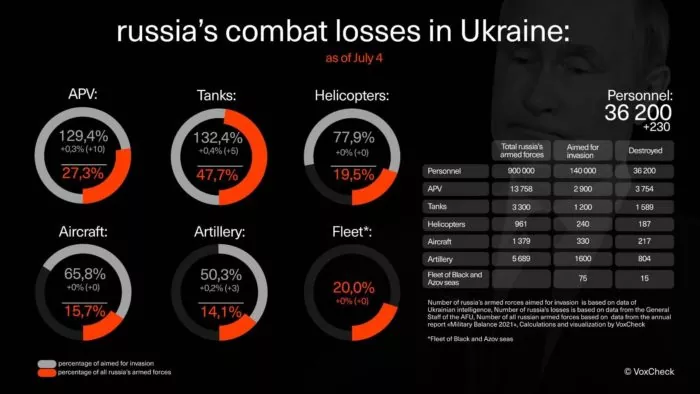
Humanitarian
Not all Lysychansk residents who wanted to evacuate were able to do so, Ukrainska Pravda reports. "However much we wanted to evacuate everyone, the number of those who wanted to leave increased in the last few days, and so did the intensity of the [Russian - ed.] shelling. We evacuated everyone we could but I think that we were probably not able to reach some of the more distant neighbourhoods in Lysychansk, Valerii Shybiko, head of the Lysychansk Military-Civilian Administration, said in a comment for Radio Svoboda.
Shybiko said that there is currently no safe route out of Lysychansk. He also confirmed that some of the civilians who remain in the city did in fact greet the arrival of the Russian army. A number of people were waiting for the Russian troops. For the most part, these are older people, those who remember the Soviet Union, who have been waiting for its return – and now they have it. They think that it’s the Soviet Union that’s arrived in their city," Shybiko said.”
Residents of Russian-occupied Mariupol dying from lack of medicines; Ukrinform reports. "The residents of occupied Mariupol are dying from the lack of medicines. In the city, there is a shortage of medicines for cancer patients, people with diabetes, tuberculosis, and thyroid gland problems," the Mariupol City Council posted on Telegram with reference to mayor Vadym Boychenko.
For more than two months, the Russians and their accomplices, the self-proclaimed authorities of Mariupol, have been blocking residents' normal access to drinking water, sufficient food and medicines. He called on the international community to assess the humanitarian disaster in the city and the genocide of its residents. The mayor urged to do everything possible to organize help for the residents of Mariupol.
Mariupol experiences one of the biggest humanitarian catastrophes caused by Russia's aggression. The city was almost completely destroyed by enemy shelling. Currently, Mariupol has no normal power, water and gas supplies. Since the beginning of the Russian invasion, up to 22,000 civilians have died in the city. More than 50,000 people have been deported to Russia and the temporarily occupied territories of the Donetsk region. Today, more than 100,000 people stay in the blocked city.”
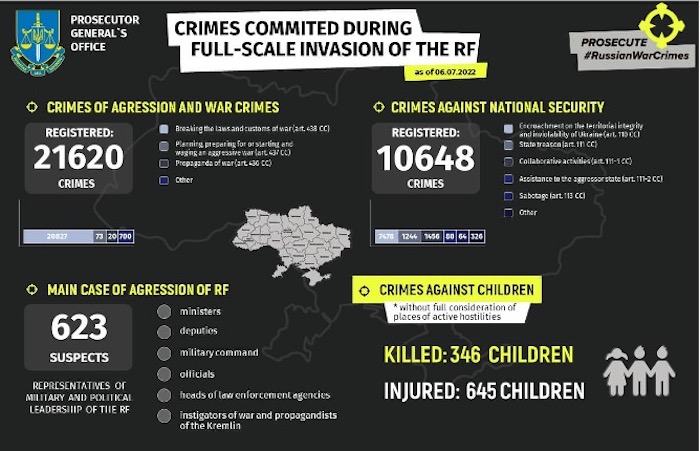
OHCHR recorded 11,152 civilian casualties in Ukraine as of July 3. 4,889 were killed (including 335 children) and 6,263 injured (including 521 children).
️️Environmental
Russian ships with stolen Ukrainian grain are staying & waiting for the Turkish decision on the Zhibek Zholy ship which delivered grain.
For the 1st time Turkey is checking the origin of grain despite Russian "documentation," journalist-investigator wrotehttps://t.co/Tu7kTESksp pic.twitter.com/Upc77IUl5U
— Euromaidan Press (@EuromaidanPress) July 5, 2022
President: 22 million tonnes of grain are currently blocked in Ukraine, Ukrinform reports. “Ukraine negotiates the creation of grain export opportunities with the UN and Türkiye. Currently, 22 million tonnes of grain are blocked at Ukrainian ports. President Volodymyr Zelenskyy noted that the implementation of the export process would be difficult but definitely possible. He emphasized Ukraine’s interest in it as an exporter.
We want our farmers to continue to work for the next year and for the next harvest. To do this, we need to export all this – barley, wheat, corn, etc. Twenty-two million tonnes are currently blocked. We expect about 60 million tonnes in autumn. There will be a very difficult situation, the President added.
As Zelenskyy informed, the efforts are made at the diplomatic level to ensure that the countries do not buy grain from the Russian Federation, which it had stolen at blocked Ukrainian ports. In addition, according to the President of Ukraine, negotiations with Türkiye and the United Nations are ongoing. He clarified that the UN takes a stand of a leader, not a moderator.
"It is a very important moment that someone guarantees the safety of the ships of certain states, except Russia, which we do not trust, those ships that will come to us to load products. This is exactly what we are talking about in Türkiye," Zelensky said.”
Norwegian oil and gas workers start strike, cutting output, Reuters reported. “Norwegian offshore workers began a strike on Tuesday that will reduce oil and gas output, the union leading the industrial action told Reuters. The strike, in which workers are demanding wage hikes to compensate for rising inflation, comes amid high oil and gas prices, with supplies of natural gas to Europe especially tight after Russian export cutbacks.
On Wednesday, the strike will deepen the cut to the country's gas output to a total of 292,000 barrels of oil equivalent per day, or 13% of output, NOG said on Sunday, in line with Equinor's estimate. Oil output from Wednesday will be cut by 130,000 barrels per day, Equinor said, in line with the lobby's earlier estimate. That corresponds to around 6.5% of Norway's production.”
Hans Petter Midttun: The strike is an example of both the consequences of ripple effects of the war, as well as the disconnects between the strike and the strategic environment. As the West is trying to counter the Russian Hybrid War, I fear most European are ignorant of the threats. Ultimately, this is a result of a lack of (or bad) strategic communication by the government. Recognizing the dramatic consequences of the strike on the European energy supply, the Norwegian government decided to intervene and stop the strike late last night.
On July 3, a diver from the Zaporizhzhia nuclear power plant was reported to die after torture by Russian occupiers. This comes as Ukrainian officials warn about a planned Russian provocation at the occupied plant that would create a major nuclear hazard.https://t.co/h8F1u0Zx6T
— Euromaidan Press (@EuromaidanPress) July 5, 2022
Legal
Arbitrary detention widespread in Russian-held parts of Ukraine - UN rights chief, Reuters reports. “Arbitrary detention of civilians has become widespread in parts of Ukraine held by Russia's military and affiliated armed groups, with 270 cases documented, the UN human rights chief said on Tuesday, announcing plans to boost monitoring in the country.
Despite restrictions on access, we have documented 270 cases of arbitrary detention and enforced disappearance. Eight of the victims were found dead," Bachelet said in an update on the situation in Ukraine in the period from Feb. 24 to May 15. The findings were based on information from monitors' field visits and interviews conducted with just over 500 victims and witnesses of human rights violations, as well as other sources of data, UN High Commissioner for Human Rights Michelle Bachelet told the Geneva-based Human Rights Council.”
The occupiers created a "Cabinet of Ministers" in the Kherson region and put Russian officials in charge, Ukrainska Pravda reports. “The occupying authorities of Kherson Oblast announced the creation of a government, appointing the vice-premier of Kaliningrad Oblast and former worker of the Federal Security Service of the Russian Federation Sergey Yeliseyev as the head of the puppet "Cabinet of Ministers”. Two more positions in the occupation pseudo-government were also given to former Russian government officials.”
The occupiers force Ukrainians to send their children to schools with a Russian curriculum, in case of refusal, they threaten to deprive them of parental rights
, the Defence Intelligence of Ukraine (DIU) claims. “In the Pologiv district of the Zaporizhzhia region, the occupying authorities force Ukrainian citizens to send their children to schools and kindergartens that work according to the Russian curriculum. They are taught by teachers and educators who came from the Russian Federation.
In case of parental disagreement, the occupation administration threatens to remove children from their families and send them to boarding schools. The parents themselves are promised to be punished by administrative measures - men will be sent to the "army of the DNR", and women will be sent to communal work related to cleaning the city.”
Russian-held part of south Ukraine aims to sell grain to the Middle East, Reuters reports. “Russian-installed authorities in the southeastern Zaporizhzhia region of Ukraine, partly under Russian control, said on Tuesday that an agreement had been reached to sell grain abroad, mainly to the Middle East, the Russian state news agency said TASS.
Ukraine has accused Russia, the world's largest wheat exporter, of stealing grain from territories that Russia's army has seized. Moscow denies this. The war has disrupted Ukraine's grain exports via the Black Sea.”
Court bans Communist Party of Ukraine, Ukrinform reports. “On July 5, the panel of judges of the Eighth Administrative Court of Appeal completed the consideration of administrative case No. 826/9751/14 on the banning of the Communist Party of Ukraine.
The court has satisfied the claims of the Ministry of Justice of Ukraine: the activities of the Communist Party of Ukraine have been banned; the property, funds and other assets of the party, its regional, city, district organizations, primary centres and other structural entities have been transferred to the ownership of the state, the statement said.”
346 children were killed, and 645 children injured, the Office of the Prosecutor General of Ukraine reports as of July 6. 2,108 educational establishments are damaged as a result of shelling and bombings, and 215 of them are destroyed fully. 21,620 crimes of aggression and war crimes and 10,648 crimes against national security were registered.
Support
Ukraine to receive self-propelled artillery systems, loitering munitions from Britain, Ukrinform reports. “Ukraine will receive ten self-propelled artillery systems and loitering munitions (suicide drones) from the United Kingdom in the coming weeks. This is said in a press release issued by the office of the head of the British government following a phone conversation between UK Prime Minister Boris Johnson and President of Ukraine Volodymyr Zelenskyy.”
Boris Johnson announces GBP100M defense aid to Ukraine from Scotland and Wales, Ukrinform reports. “Two members of the United Kingdom – Scotland and Wales – have approved decisions on allocating security assistance to Ukraine worth a total of GBD100 million. That’s according to UK Prime Minister Boris Johnson.”
Ukraine needs $750 bln for a recovery plan, prime minister says, Reuters reports. “Ukraine needs $750 billion for a three-stage recovery plan in the wake of Russia's invasion, its prime minister said on Monday. Denys Shmygal also told the Ukraine Recovery Conference hosted by Switzerland that there had been over $100 billion of direct damage to Ukrainian infrastructure from Russia's invasion.”
Russian troops fired 6 missiles at administration buildings in Bashtanka near Mykolaiv, 3 were shot down. Besides, in Mykolayiv, residential buildings were destroyed as a result of morning Russian airstrikes. Info about victims is being updated, Obl Head https://t.co/73Sze1fOVw pic.twitter.com/QTNJFltHmE
— Euromaidan Press (@EuromaidanPress) July 5, 2022
Zelenskyy: Reconstruction of Ukraine should start now, Ukrainska Pravda reports. “The Ukraine Recovery Conference (URC2022) began in the Swiss city of Lugano on Monday and will last for two days. More than 40 states and more than 20 international organisations have been invited to participate in the conference. Ukrainian President Volodymyr Zelenskyy, who spoke remotely, outlined his vision for reconstruction and also stressed the need for reforms. European Commission President Ursula von der Leyen announced the creation of an EU platform for rebuilding Ukraine after the war unleashed by Russia.
When they talk about reconstruction, the emphasis is often misplaced. It is not only about what we should do after our victory or in the years to come. Yet, above all, [it is about] what we need to do right now, President Zelenskyy said in a video address. Volodymyr Zelenskyy stressed that the Ukrainian Armed Forces had already liberated over a thousand settlements from Russian forces. All of them have suffered large-scale destruction. This also means they need colossal funds for the restoration of infrastructure, to restore medicine and social services, and the restoration of normal economic life. There are tens of thousands of destroyed residential buildings in the liberated areas alone. And we also need to prepare schools and universities for the new academic year across the entire free territory of the country and under new conditions of constant threat, in particular missile strikes, he said. The President also noted that it is necessary to prepare for winter in order to let the season pass calmly despite the threats posed by Russia.
A significant part of the economy has been destroyed by hostilities and Russian strikes. Thousands of enterprises are out of business. This means a high need for jobs, for ensuring social benefits despite the decrease in tax revenues, Zelenskyy added.”
Over 40 Nations Vowed to Support Ukraine’s Recovery, European Pravda reports. “Representatives of more than 40 countries, along with multilateral organizations such as the European Investment Bank and the Organization for Economic Cooperation and Development, signed the Lugano Declaration outlining a roadmap for Ukraine's recovery.
The adopted declaration provides Ukraine with political, financial, and technical support. The declaration is based on the recovery and development plan presented by Ukraine on Monday at the Conference on Ukraine's restoration in Lugano, "Government Portal" reports.”
New Developments
The Russian Federation is an empire and Putin’s decision to invade Ukraine has hastened its disintegration, St. Petersburg historian Aleksandr Etkind writes: https://t.co/EOwL5YzX8J
— Euromaidan Press (@EuromaidanPress) July 5, 2022
- Putin ordered "rest" for the troops that captured the Luhansk region, Ukrainska Pravda reports, citing TASS. “Russian President Vladimir Putin instructed Russian Defence Minister Sergei Shoigu to give rest time to the troops who took part in the seizure of the Luhansk region.”
- War will end when Ukraine reaches its 1991 borders - Head of Ukrainian Intelligence, Ukrainska Pravda reports, citing RBC-Ukraine. "Reaching the 1991 borders will be the end of this whole adventure that Russia has undertaken. [Kyrylo Budanov, head of the Defence Intelligence of Ukraine (DIU)] believes that this may happen as early as next year. According to him, the first visible results of the turning point could be observed in August, and by the end of the year the intensity of hostilities will decrease.”
- Shoigu reports that the war in Ukraine will end with the fulfillment of all the tasks set by Putin, Ukrainska Pravda reports, citing both RIA Novosti and Russian Interfax. "Today, the main priorities for us are the preservation of life and health of subordinate personnel, and the elimination of threats to the safety of the civilian population. The special military operation will continue until the tasks assigned by the Supreme Commander are completed, [Russian Defence Minister Sergei Shoigu said].”
- Russian parliament passes the first vote on war economy measures, Reuters “The Russian government will be able to compel businesses to supply the military with goods and make their employees work overtime under two laws to support Moscow's war in Ukraine that was approved in an initial vote in parliament on Tuesday. The measures will effectively place Russia on a war economy footing, nearly 19 weeks into the invasion which it describes as a "special military operation".”
7th EU sanctions package on Russia must include: complete disconnection of all banks from SWIFT & Russia cut off from maritime trade.
The largest supplier of tankers for transportation of Russian oil by sea are private Greek companies, Ukraine's MFA said https://t.co/DOFopXJarV
— Euromaidan Press (@EuromaidanPress) July 5, 2022
- EU has not yet agreed on the seventh package of sanctions against Russia, Ukrinform “The European Union has not yet reached an agreement on the content of the seventh package of sanctions against Russia or on the date for its adoption. Swedish Prime Minister Magdalena Andersson said this at a joint briefing with Ukrainian President Volodymyr Zelensky in Kyiv on Monday.”
- reports, citing
- Finland and Sweden sign to join NATO but need ratification, Reuters “NATO's 30 allies signed an accession protocol for Finland and Sweden on Tuesday, allowing them to join the nuclear-armed alliance once parliaments ratify the decision, the most significant expansion of the alliance since the 1990s.”
Assessment
- On the war.
The Institute for the Study of War has made the following assessment as of Saturday 6 July, 2022:
The Institute for the Study of War has made the following assessment as of Tuesday 05 July:
“Russia’s stated objectives in its invasion of Ukraine remain regime change in Kyiv and the truncation of the sovereignty of any Ukrainian state that survives the Russian attack despite Russian military setbacks and rhetoric hinting at a reduction in war aims following those defeats. Russian Security Council Secretary Nikolai Patrushev stated on July 5 that the Russian military operation in Ukraine will continue until Russia achieves its goals of protecting civilians from “genocide,” “denazifying” and demilitarizing Ukraine, and obliging Ukraine to be permanently neutral between Russia and NATO—almost exactly restating the goals Russian President Vladimir Putin announced in his February 24 speech justifying the war. Putin had stated that the operation aimed to protect civilians from humiliation and genocide, demilitarize and denazify Ukraine, and prosecute genocidal perpetrators. Patrushev’s explicit restatement of Putin‘s initial objectives, nearly five months later, strongly indicates that the Kremlin does not consider recent Russian gains in Luhansk Oblast sufficient to accomplish the initial goals of the "special operation,” supporting ISW’s ongoing assessment that the Kremlin has significant territorial aspirations beyond the Donbas. Patrushev’s statement suggests that Russian military leadership will continue to push for advances outside Donetsk and Luhansk blasts and that the Kremlin is preparing for a protracted war with the intention of taking much larger portions of Ukraine.
Patrushev’s statement is noteworthy because of its timing and his position as a close confidante of Putin. Patrushev is very unlikely to stray far from Putin’s position in his public comments given his relationship with Putin and his role in the Kremlin. His restatement of virtually the same maximalist objectives that Putin laid out before the invasion even as Russian forces seemed to be closing in on the more limited objectives of securing Donetsk and Luhansk oblasts—which Putin and other Russian leaders had hinted were their new aims following their defeats around Kyiv—strongly suggests that those hints did not reflect any actual change in Kremlin policy. Patrushev’s statement significantly increases the burden on those who suggest that some compromise ceasefire or even peace based on limited additional Russian territorial gains is possible, even if it were acceptable to Ukraine or desirable for the West (neither of which is the case).
Igor Girkin, a Russian nationalist and former commander of militants in the 2014 war in Donbas, responded to Patrushev’s statements and continued expressing his general disillusionment with the Kremlin’s official line on operations in Ukraine. Girkin said that the intended goals of “denazification” and “de-militarization” will only be possible with the total defeat of the Ukrainian military and the surrender of the Ukrainian government. Girkin noted that Russian victory is premised on the capture of "Novorossiya”—a notional territory that encompasses eight Ukrainian oblasts, including the Donetsk and Luhansk oblasts and much of eastern and southern Ukraine. Girkin also claimed that the capture of “Novorossiya” is the bare minimum and that Russian goals will be realized through the total capture of “Malorossiya,” which is an invocation of the Russian imperial concept for almost all Ukrainian territory. Girkin is once again pushing back on the Kremlin line, which he views as insufficient in securing Russian objectives in Ukraine. Luhansk People’s Republic (LNR) Ambassador to Russia Rodion Miroshnik similarly suggested that the Kremlin has not yet met its goals in Ukraine, despite reaching the borders of his claimed oblast, and stated that LNR authorities are still not confident in the security of the LNR. Girkin and Miroshnik’s statements, taken together, indicate that Russian nationalists continue to push for further territorial gains and, at least in Girkin’s case, full-scale regime change and the incorporation of most of Ukraine into Russia. Patrushev’s statement suggests that Kremlin thinking may not be that far removed from these extremist nationalist ambitions.
Key Takeaways
- Russian Security Council Secretary Nikolai Patrushev restated Russian President Vladimir Putin’s initial objectives for operations in Ukraine, suggesting that the Kremlin retains maximalist objectives including regime change and territorial expansion far beyond the Donbas.
- Russian forces continued offensive operations northwest and east of Sloviansk.
- Russian forces are attempting to advance west of the Lysychansk area toward Siversk.
- Russian forces are likely attempting to gain access to village roads southeast of Bakhmut in order to advance on the city from the south.
- Ukrainian forces conducted a limited counterattack southwest of Donetsk City.
- Russian forces continued limited and unsuccessful assaults in northern Kharkiv Oblast.
- Russian authorities are conducting escalated conscription measures in occupied territories to compensate for continuing manpower losses.
- Russian authorities are continuing to consolidate administrative control of occupied areas of Ukraine, likely to set conditions for the direct annexation of these territories to the Russian Federation.“ (unquote)
Russia does not plan to "limit itself to Donbas" but wants the complete destruction of Ukraine, Ukrainska Pravda reports, citing RBC-Ukraine. Commenting on international partners' intelligence data, Kyrylo Budanov, head of the Defence Intelligence of Ukraine (DIU) said that the DIU is guided by its own information and that Russia's goal is the complete destruction of Ukraine's statehood.
"Once again I would like to reiterate that we were the ones who were the first to say what would happen and how it would happen. So I can tell you irrefutably that Russia's plans are the total annihilation of Ukraine, the absolute total annihilation. And [as for] any insinuations about whether Donbas might be enough for them, please don't even ask me questions like that. We will not trade territory."
Russia Advances Behind Brutal Barrage, but Will Its Strategy Keep Working, The New York Times asks? “Russia’s capture of the cities of Sievierodonetsk and Lysychansk […] demonstrates the success of the Russian military’s grinding strategy based on superior firepower and incremental advances. It also raises serious questions about how long either side can keep going like this, particularly the battered and vastly outgunned Ukrainian forces, forced to rely on raw recruits and suffering heavy casualties, along with the mental strain of combat, retreat and constant Russian shelling.
Russia’s invasion has taken a brutal toll on its own forces as well, but they continue their slow advance, and with the seizure of Lysychansk this weekend, they have taken control of the entirety of Luhansk Province, putting them in position to push on toward Ukrainian-held cities in Donetsk Province.
The devastating strategy, relying heavily on long-range artillery, suits the flat terrain and shorter Russian supply lines in the east, but might not work elsewhere. And it remains unclear how far President Vladimir V. Putin intends to press the offensive, or how much more loss of men and matériel his military can absorb without needing a long pause to rebuild.
Ukrainian officials say that their goal is to inflict maximum pain on the Russians by forcing them to fight for cities, as happened in Sievierodonetsk and to a lesser extent in Lysychansk, but both cities fell, and now there are rising doubts about that approach. The strategy is also divisive among Ukrainian troops, some of whom believe that attempting to hold cities is fruitless. […]
Volodymyr, a volunteer soldier who was one of the last members of his unit to pull out of Sievierodonetsk in June, said he had lost more than half his company of around 100 soldiers during the battle. He summarized the battle with an expletive. “What support?” he asked. “There was no support.” He nodded, however, at the Ukrainian T-80 tank across the street, saying tank units did come to the soldiers’ aid when artillery backup did not. […]
Russian troops rarely advance without an overwhelming amount of backing, often in the form of heavy artillery bombardment — even if that means that what Moscow captures is in ruins. Ukrainian soldiers say that the shelling lasts for about five days before Russian forces begin testing Ukrainian lines with foot soldiers and tanks.
The fighting has clearly exhausted both sides. Ukrainian officials have estimated that their forces are suffering hundreds of casualties a day; Western intelligence puts Russian deaths and injuries at a similar level.
Ukrainian forces are increasingly relying on lesser-trained troops such as those from the territorial defense forces and National Guard to supplement exhausted units on the front lines. And Russia has turned to reinforcements such as Wagner paramilitary units, pro-Moscow Chechen forces and separatist fighters from Luhansk and Donetsk to reinforce their casualty-plagued units. […]
Both sides have played down reports of faltering morale in their ranks, sometimes posting motivational videos on social media to counter the notion that anyone in the trenches is exhausted. And even as casualties wear them down, Ukrainian troops are displaying a willingness to continue fighting, no matter the cost. “We’ll go back” said Volodymyr, after retreating from Sievierodonetsk. “This is our land. This is how it is.” […]
More than four months into the war, Ukrainians remain angry and defiant. But among civilians — millions of them displaced, out of work and living in fear, some lacking adequate food, water and electricity — the mood is increasingly somber. As the Russians gain ground and losses mount, with no end in sight, some Ukrainians accuse their government of minimizing the challenges ahead in a bid to raise morale. […]
In the south, near the Russian controlled port-city of Kherson, Ukrainian forces have made a series of small gains over the past month. And though military analysts say these incremental victories are a sign of a coming broader counteroffensive, Ukrainian military officers have downplayed the fighting and acknowledged that the focus is on the east.
Kyiv has frequently called for more Western-supplied weapons and ammunition. And while some have made it to the front and proved successful in combat, especially the recently arrived HIMARS multiple rocket launch system from the United States, any longer-term Ukrainian success on the battlefield would require much more. […]
For both sides, air support has mostly been a secondary part of the fighting in Donbas, or even absent. Russia and Ukraine both have significant air defenses in place in the east, meaning that most jets and helicopters have to fly dangerously low to provide a modicum of support for ground forces. That has left Russian forces firing cruise missiles to target key infrastructure behind the front lines.”
The occupiers are preparing to mobilise in the south of Ukraine, Ukrainska Pravda reports, citing the website of the Special Operations Forces "Sprotyv" [Resistance]. "According to our data, Russian forces have begun preparations for recruitment in Berdiansk, where the heads of homeowners associations have been ordered to submit lists of building residents of recruitment age. It bears repeating that a Russian passport is a condition for mobilisation; these are being issued by the Russians in the occupied territories.
We should also note that the Russians have once again increased the pace of mobilisation in the occupied Luhansk region, in particular, they have taken all the men from the Luhansk meat processing plant and the ‘Luhansk State Academy of Culture’ into the army."
2. Consequences and what to do?
How united is the West on Russia, The Washington Post asks? As our new public opinion data show, Russia’s invasion of Ukraine has triggered a convergence of views among NATO’s most powerful members. In the Strategic Concept, NATO allies describe Russia as “the most significant and direct threat to Allies’ security and to peace and stability in the Euro-Atlantic area.” Surveys now show people in Canada, Germany, France, Italy, the United Kingdom, and the United States have become more willing to push back against Russia.
Russia’s invasion of Ukraine marks a turning point
In the run-up to this year’s G-7 summit and NATO summit, we conducted a new wave of surveys solely in the G-7 countries to find out how public risk perceptions have changed since Russia’s invasion of Ukraine. […] The May results […] indicate that between 60 and 70 % of respondents agree with the statement that “the invasion of Ukraine represents a turning point in world politics” […].
Absolute majorities in all countries surveyed also say that “we are entering a new cold war with Russia.” These findings are in line with other polls, including one suggesting that “Europe’s break with Russia is irreversible, at least in the short and medium term,” and another that tallied record unfavorable opinions of Russia.
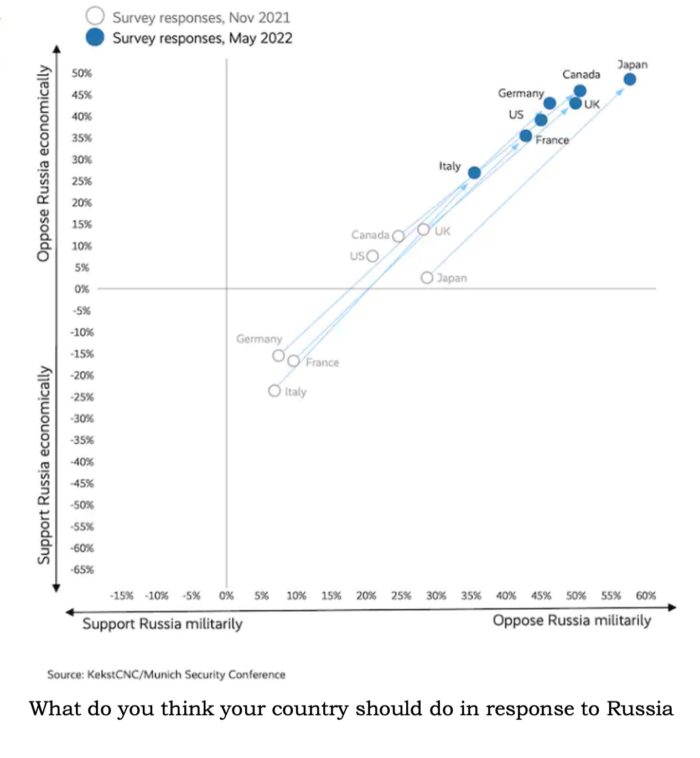
G-7 citizens are willing to push back against Russia
Compared to a November 2021 version of the index, respondents have become far more willing to see their country oppose Russia, both economically and militarily, as the figure below shows. Previous differences in how continental Europeans and the English-speaking members of the G-7 favored how to approach Russia have almost disappeared. In fact, respondents in Italy, the most reluctant to stand up to Russia in November 2021, are more hawkish now than U.K. respondents — the most hawkish in that month’s survey — were at that time.
Respondents are also willing to provide military support. NATO countries have given Ukraine weapons, intelligence and nonmilitary support to fight off the invasion. Other than Italy, an outlier in other surveys as well, more respondents say their country should do more to support Ukraine with weapons. People in Canada, the U.K. and the US are significantly more supportive of doing more than those in continental Europe, however.
G-7 citizens seem less concerned about escalation than their leaders. Some officials fear that Russian President Vladimir Putin may see the supply of advanced systems as a reason to attack NATO countries, and thus continue to argue about the type of weapons that NATO members should send to Kyiv.
In contrast, relative majorities in Italy (38 % ), Germany (44 % ), France (48 % ) and the United Kingdom (50 % ), as well as absolute majorities in Canada (51 % ) and the United States (53 % ) agree with the statement that “NATO members should push back harder against Russia even if the risk of military escalation between NATO and Russia increases.” The only countries in which more than a quarter of respondents disagree are Italy (27 % ) and Germany (26 % ).
Ramping up NATO defenses
Respondents also seem ready to consider a major overhaul of NATO’s eastern flank, one of the key issues discussed at the summit. While a considerable part of the public in the NATO members surveyed remains undecided (from 31 % in Germany to 41 % in Canada and Italy), pluralities in Canada (43 % ), France and the U.K. (both 46 % ), Germany (48 % ) and the US (49 % ) say that their country “should massively increase its military presence at NATO’s eastern border.”
In the absence of clear public opposition, politicians in Canada, Germany, the U.K. and the US can thus build on general support for a major change in NATO’s strategic posture. These are the four countries leading the multinational battalions stationed as NATO’s forward presence in Poland and the three Baltic nations.
Expand the alliance?
[…] Supporters outnumber opponents in G-7 countries when it comes to whether Ukraine should be able to join NATO, we found. The net scores (those who support Ukraine’s bid minus those who oppose it) we tallied are generally slightly lower vs. questions on E.U. membership for Ukraine, but continental Europeans vs. other NATO members diverge in their views. We found net scores on the question of Ukraine’s joining NATO lower in Italy (+14), Germany (+16) and France (+28), compared to scores in the US (+44), the U.K. (+44) and Canada (+58). […]
Overall, respondents appear ready to support measures going beyond the policy framework that has long guided the Western approach toward Russia. These survey results suggest people believe we’re in for a long confrontation with Russia and are increasingly willing to oppose Russia economically and militarily. Respondents also appear open to expanding NATO’s membership to include more countries bordering Russia. At least for public opinion, it is a “Zeitenwende” indeed.”
Hans Petter Midttun:
The survey published by The Washington Post is encouraging reading as it indicates an increased understanding of the “new” strategic environment and willingness to defend democracy and our core values and principles.
I believe our political leaders share the sentiments. When they have decided on another course of action, it is probably not for a lack of will but rather a lack of ability. These – will and ability – are the core elements of any military operation. There is no point in pursuing military options (“will”) if one lacks the tools needed to achieve the desired effect (“ability”).
That’s why my previous assessment probably remains valid. It is highly possible the Alliance and its member states need more time to prepare themselves for a confrontation that has already started.
NATO is accepting a protracted war despite its dramatic consequences because the Alliance needs more time. More time to generate new forces, procure more arms, sensors, command and control systems, build sustainability, and not least, rebuild the defence industry to achieve all of this. Time might is crucial as NATO is facing shortcomings after decades of underbudgeting, streamlining, and downsizing. Observations from positions I have held in the past, unfortunately, do not make this assessment as farfetched as one would wish.
Their decision is, however, also influenced by at least two other factors.
One is the “fear” factor and the idea that “a military intervention by NATO in the war in Ukraine because this would lead to a military world war". The battlefield exists in both the physical as well as the cognitive sphere. The Hybrid War aims to destabilize, create fear, and promote passivity. It confuses and manipulates. Through disinformation, lies, cyber-attacks, extortion, provocations, fabrications, military escalation, and more, a "virtual reality" is created that motivates countries to make the political decisions Russia wants. Some of the decisions and policymakers will, therefore, believe in the Russian-induced scenario.
The other is related to the challenges NATO itself is facing. Having 30 nations agree on military intervention – some fearing the repercussions and lacking the military capabilities and sustainability needed – has limited NATO's level of ambitions to the maximum of what the “weakest links” will allow. A number of its member states are not at all prepared for war.
The bottom line is that our political leaders are empowered to do much more for Ukraine than they are presently doing. At one stage, they will also realise that they need to do more if they want to avoid the fallout of doing too little, too late. They will be held accountable for not stopping Russia and allowing the “tsunami of ripple effects.”



